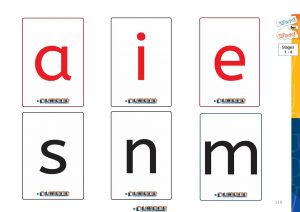English, Word for Word
Using Word for Word in the Classroom: Lesson Logistics
Although this post is written with teachers using Word for Word with a whole class in mind, it should be helpful to anyone delivering Word for Word.
Introducing Phonemes and Graphemes
When Word for Word is first introduced, your focus is simply on teaching the stage 1 phonemes and graphemes. Introducing a phoneme (sound) is done as follows:
- Show the pupils the grapheme card as you say the phoneme.
- Have them say it after you.
- Repeat several times (always showing the grapheme card as you / they say the phoneme).
- Show the pupils how to write the letter in the air (be careful as you model this – if you are facing the pupils, you will need to write it backwards!), and have them ‘write’ it in the air whilst saying the sound.
- Practise until the pupils are confidently forming the letter.
- Say lots of words that include the sound in different positions in the word, accentuating the sound as you say the word, e.g., mmman, rammm, jummmp.
- Show the grapheme card again and ask pupils to tell you the phoneme.
- From a selection of grapheme cards on the table, can the pupil find the correct one when you call out the phoneme?

It is recommended you work initially at whole-class level before working with small groups to allow you to assess each child’s receptive and expressive knowledge of the various phonemes and graphemes. In simple terms, scheduling time for group work affords you the opportunity to check if pupils can say the correct sound when you point to a letter or point to (and later write) the correct letter when they hear a sound.
To manage this successfully, it is helpful to group pupils and create a visual timetable for them. Create a carousel of activity stations for pupils to rotate through when you call ‘change.’ In this way, all pupils are using their time productively and you are able to work with small groups or 1:1 with children requiring additional support.
Word for Word Stages 1 – 4 contains pages of activity ideas for the development of fine motor skills that you may use as the basis for your stations. It is useful to devote much time at the outset training pupils to work in stations and establishing your expectations of them, e.g., they must not interrupt you unless they have a very good reason (discuss what such reasons might be).
Investing time in modelling and practising group work at various stations will pay dividends later as your pupils work independently and cooperatively, affording you time to work with small groups.
In these introductory lessons, much time will be devoted to ensuring children master the movements required to correctly write various graphemes. They will begin with “air-writing” and tracing activities before moving on to writing the letters with a variety of implements on a variety of media.
It is also advisable to include rhymes, poems, and songs to support the development of phonological awareness.
Sample Lesson Structure Following Completion of Stages 1 and 2
Once pupils have been taught some initial sounds, a typical Word for Word lesson for a whole class may be structured as follows:



At the outset, it can take some time to embed the routines of Word for Word. Therefore, if you have access to a support assistant or a team-teaching colleague, it is helpful to ask for their support in delivering Word for Word. As you and your pupils become familiar with Word for Word, you will find lessons flow smoothly, pupils gain confidence and their independence and pace of work grows.
